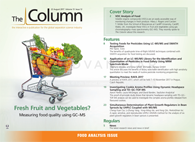VOC Analysis of Food
Fresh fruit and vegetables have a limited shelf life and so there is a need to ensure that the products reach the shelf in a timely manner and with as little spoilage as possible. Volatile organic compounds (VOCs) are an easily accessible way of monitoring changes in fresh produce. Hilary J. Rogers and Carsten T. Müller from the School of Biosciences at Cardiff University, Cardiff, Wales, UK, investigate these VOCs in fruit and vegetables using gas chromatography–mass spectrometry (GC–MS). They recently spoke to The Column about this research.
Photo Credit: kurhan/Shutterstock.com

Fresh fruit and vegetables have a limited shelf life and so there is a need to ensure that the products reach the shelf in a timely manner and with as little spoilage as possible. Volatile organic compounds (VOCs) are an easily accessible way of monitoring changes in fresh produce. Hilary J. Rogers and Carsten T. Müller from the School of Biosciences at Cardiff University, Cardiff, Wales, UK, investigate these VOCs in fruit and vegetables using gas chromatography–mass spectrometry (GC–MS). They recently spoke to The Column about this research.- Interview by Kate Mosford
Q. Your group has been investigating volatile organic compound (VOC) profiles in fresh fruit and vegetables using gas chromatography–mass spectrometry
(GC–MS) (1–3). Please could you explain the importance of monitoring these profiles throughout the supply chain.
A: Fresh fruit and vegetables are perishable products with a very short shelf life. This results in wastage during the supply chain and the risk that products will not be of optimal quality when they reach the consumer. Our research as part of an EUâfunded project under the FP7 programme (QUAFETY) was aimed at developing tools that would help the industry to monitor quality of fresh produce through the supply chain. Volatile organic compounds (VOCs) offer an easily accessible way of monitoring changes in the fresh produce with minimal extraction input. Our project was then focused at linking changes in VOCs with changes in internal quality such as nutritionally important compounds that are not as easily measurable including vitamin C and other metabolites such as flavonoids. Another potential issue with fresh cut salads is the potential for contamination with human pathogens at harvest or during processing that can rise to dangerous levels through storage. An analysis of changes in VOCs could provide a useful method for detecting changes in microbial populations.
Q. Is there a significant loss of nutritional compounds down the supply chain? Is there a set time frame for food process and supply-from field to fork?
A: One of the key methods used by the industry to slow down deterioration in fresh produce is by storage and transport at reduced temperatures. However, despite this, there is a decrease in the more labile metabolites including, for example, vitamin C. The time from field to fork varies with the produce-the industry sets shelf life limits usually expressed as “sell by” or “use by” or “best before” often based on empirical assessments of appearance from external qualities, however, these estimates are not always linked to nutritional content.
Q. Ready-to-eat fresh fruits and vegetables are becoming more and more popular. Why did you choose to analyze fresh cut melon and rocket salad in particular?
A: Melons are an important component of fruit salads and vulnerable to damage during processing. They are also valued for their aroma, which changes noticeably during the shelf life of ready-to-eat cut fruit. They therefore provided a useful model to test the development of our VOC-based quality assessment methods. Rocket salad is rich in glucosinolates, which are broken down to isothiocyanates-volatile compounds-when the leaves are damaged, for example, when they are eaten. Isothiocyanates have important nutritional properties in protection against cancer and cardiovascular disease. We were therefore interested to follow changes in isothiocyanates during shelf life. Rocket salad is also a rich source of vitamin C so we were interested to discover whether there was a correlation between changes in VOCs and changes in vitamin C.
Q. What are the biggest challenges in VOC analysis of food?
A: Perhaps the greatest difficulty in the analysis of VOCs from food samples is the complexity of the aroma bouquet. This bouquet includes large numbers of different compounds-sometimes hundreds-which can be present in dramatically different concentrations. In some detection systems, this can result in saturation of the more abundant compounds making their quantitation difficult, as well as the masking of components of lower concentration that are similar in structure. In addition, some compounds are very similar structurally and therefore can be difficult to identify unequivocally. Finally, our perception of VOCs through our sense of smell can be very different to the sensitivity of instrumentation. Hence for an assessment of organoleptic quality it is important to link the objective measurements of VOC concentrations to changes in perception using more subjective assessments by people as part of sensory panels.
Q. What is novel about your research and what were your main findings?
A: Most previous studies on fresh cut fruit and salads have required the plant material to be homogenized or further extracted prior to analysis of VOCs. In addition, the most widely used system of analysis-solidâphase microextraction (SPME)-is based on partitioning VOCs onto the fibre. This equilibrium process can a) lead to saturation with dominant compounds and b) result in profiles that are not necessarily a true reflection of the actual relative concentrations of VOCs in a sample because each analyte affects the partition of the other. By using thermal desorption gas chromatography coupled to time-of-flight mass spectrometry (TD–GC–TOF-MS) we circumvented these limitations and obtained sufficient sensitivity to detect a wide spectrum of VOCs from the fresh cut produce without further manipulation. Furthermore, the TD–GC approach enables the collection of VOC samples remotely and their safe storage during transport for analysis in our laboratory. We were also able to show that this approach would be useful for collecting samples of VOCs remotely in the supply chain. Our key findings are a correlation between a small number of VOCs in rocket salad to changes in vitamin C and a fall in organoleptic quality, which was also detectable in rocket salad from the supermarket shelf. In addition, we were able to show that an analysis of VOCs in melons could detect changes in populations of the human pathogen Listeria that could be used for assessing contamination in the supply chain.
Q. Does your group focus on other areas of food analysis using chromatography?
A: Current work in our group is focused on long-term storage of garlic and the use of VOCs at warehouse-scale to identify changes in quality that might affect processing quality for high value chemicals or food use in collaboration with a Cardiff company Neem Biotech. We are again using the TD–GC–TOFâMS equipment to do this and we hope this will provide a useful analysis for the industry. We are also linking our VOC analysis with transcriptomic analysis to assess changes in metabolic pathways affecting the production of nutritionally relevant and spoilage-related compounds in garlic and other horticultural produce.
Q. What areas of food analysis will your group focus on next?
A: We have just started a collaborative project with the University of Calabria in Italy, funded by the Italian “Fondazione con il Sud” to use VOC analysis for the assessment of peach quality during transport for export from Southern Italy. One of the problems with harvesting fruit at the optimal stage for transport and then long periods of cold temperature transport is that the production of aromas is often adversely affected and may not recover once the fruit is restored to room temperature for sale. We are interested to discover the effects of chilling on aroma development at a biochemical and gene expression level and how changes in postâharvest treatments might improve the quality of the fruit that we eat.
References
- N.D. Spadafora, I. Machado, C.T. Muller, M. Pintano, M. Bates, and H.J. Rogers, Acta Hortic.1071, 787–793 (2015) DOI: 10.17660/ActaHortic.2015.1071.104.
- N.D. Spadafora, A.L. Amaro, M.J. Perira, C.T. Muller, M. Pintado, and H.J. Rogers, Food Chemistry211, 114–123 (2016).
- N.D. Spadafora, S. Paramithiotis, E.H. Drosinos, L. Cammarisano, H.J Rogers, and C.T. Müller, Food Microbiology54, 52–59 (2016).

Carsten T. Müller is a Senior Lecturer in chemical ecology, at the School of Biosciences, Cardiff University (Wales). He studied for his Diplom (M.Sc.) in chemistry at the University of Kiel and the University of Oldenburg (Germany), his Dr rer nat (PhD) in marine chemical ecology at the University of Oldenburg, before joining Cardiff University as MSC Fellow with a project on marine invertebrate ecology. His research focuses on the analysis of complex bouquets of VOCs, which constitute scent and smells, with the aim to access such information, to inform research into behaviour and ecology, and to design commercial applications. Chemical signalling in general is a fundamental process in all organisms. Chemical substances and mixtures feature in communication and defence between organisms and carry information on status, health, and condition. In a recent EU project and in ongoing work in his laboratory, he has been using TD–GC–TOF-MS to identify patterns of VOCs emitted post-harvest by a range of horticultural produce and linking these to storage and processing conditions as well as their nutritional status, safety, and quality.

Hilary J. Rogers is a Reader in Plant Molecular Sciences, at the School of Biosciences, Cardiff University. She obtained her B.Sc. and Ph.D. from London University, and performed her postdoctoral research on plant gene expression in Cambridge and London. Her research focuses on understanding the regulation of plant organ senescence both in model plants and in horticultural produce including cut flowers, fruits, and leaves. This involves understanding the genes that control this process and also the changes in biochemistry and plant physiology. In a recent EU project and in ongoing work in her laboratory, she has been using TD–GC–TOF-MS to identify patterns of VOCs emitted post-harvest by a range of horticultural produce and linking these to storage and processing conditions as well as their nutritional status, safety, and quality.
E-mail:rogershj@cf.ac.uk / MullerCT@cardiff.ac.ukWebsite: www.cardiff.ac.uk/people/view/81265-rogers-hilary / www.cardiff.ac.uk/people/view/81237-muller-carsten

Analytical Challenges in Measuring Migration from Food Contact Materials
November 2nd 2015Food contact materials contain low molecular weight additives and processing aids which can migrate into foods leading to trace levels of contamination. Food safety is ensured through regulations, comprising compositional controls and migration limits, which present a significant analytical challenge to the food industry to ensure compliance and demonstrate due diligence. Of the various analytical approaches, LC-MS/MS has proved to be an essential tool in monitoring migration of target compounds into foods, and more sophisticated approaches such as LC-high resolution MS (Orbitrap) are being increasingly used for untargeted analysis to monitor non-intentionally added substances. This podcast will provide an overview to this area, illustrated with various applications showing current approaches being employed.
New Study Reviews Chromatography Methods for Flavonoid Analysis
April 21st 2025Flavonoids are widely used metabolites that carry out various functions in different industries, such as food and cosmetics. Detecting, separating, and quantifying them in fruit species can be a complicated process.

.png&w=3840&q=75)

.png&w=3840&q=75)



.png&w=3840&q=75)



.png&w=3840&q=75)


![IMG_4773[1].jpg IMG_4773[1].jpg](/_next/image?url=https%3A%2F%2Fcdn.sanity.io%2Fimages%2F0vv8moc6%2Fchroma%2F6db719ea80519dad8e948ad595b96c3fa3731826-200x207.jpg%3Ffit%3Dcrop%26auto%3Dformat&w=3840&q=75)








